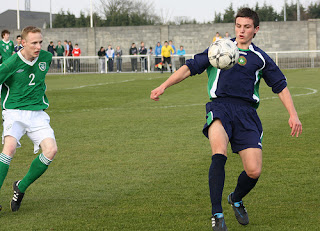
 |
| Markets Field, Limerick: 3G pitch hosting big inter-varsity cup |
the most prestigious competition in Irish university football (the Collingwood Cup) will break new ground this year when the event will be played on a 3G artificial surface for the first time in its history. The competition takes place in Markets Field Limerick from 21st - 24th February.
Professional football in the UK tried dealing with this problem by introducing "plastic pitches" in the 1980's on lower league grounds who couldn't afford the constant care needed to maintain grass pitches. Within 10 years, those pitches had been made illegal due to the problems (unpredictable bounce; impossible sliding tackles; balls careering all over the place) and injuries (on concrete like surfaces) often worse than those sustained on the pitches they were trying to combat!
That was the 1980's (and early 90's) though. This is 2012. I have viewed an (artificial) all weather fourth generation pitch here in Mayfield in Cork city today. If I had not been told the grass was fake, I would have thought it was real - aside from the fact that the surface was in perfect condition of course! The simple fact is that amateur and lower league clubs simply don't have the money to maintain grass pitches ruined by bad weather and constant use.
 |
| Groundsmen won't be smiling when new surfaces introduced |
Attitudes have changed drastically to artificial pitches over recent years. The reasons for this are twofold. One is obvious; the fact that the quality of artificial surfaces has improved dramatically in the 21st century. Secondly is economics. Teams can train on these artificial pitches. Youth teams also; meaning considerable sums can be saved on renting training pitches. Instead of just being capable of hosting 20-30 games a season on a grass pitch; these new pitches can be used seven days a week, 365 days a year. There is also the concern of cancelling games in mid-winter. When a game is cancelled at the last minute it cost up to £100,000 for lower league clubs in terms of the costs of policing/stewarding/licencing/match officials etc and the fact that tickets must be valid for the game when it is eventually re-scheduled.
 |
| Stuart Pearce: happy with new surface |
"Unlike the Astro Turf pitches I played on when I was younger, this gives a true roll of how a football pitch should be," - Stuart Pearce
(as seen on Sky Sports News)
During November last; Football League clubs were given a presentation about the pros and cons of artificial pitches. There will be another discussion in February, followed by a possible vote in June.
Geoff Webb, Chief Executive of the Institiute of Groundsmanship says that permitting artificial surfaces would be a mistake. "Why fix something that is not broken?" he said. "I think pitches throughout the Football League and the Premier League are seen pretty much as the world's best and they are an asset for football. Some people think the artificial surfaces are maintenance free but they are not. The artificial pitches are not all weather. If it gets really cold and icy, you might have to cancel a game."


No comments:
Post a Comment